
How do you stay on top of a full pipeline, discover how to improve your sales process, and continue to deliver personalized outreach to every one of your prospects?
You can’t on your own. But you can with conversational AI.
This isn’t just a tool that creates automated chatbots to take the load off your customer service team. You can also use conversational AI to give sales reps and managers everything they need to spot revenue leaks and close deals faster. In this article, we’ll show you how.
Table of Contents:
- What is conversational AI?
- How does conversational AI work?
- What are the benefits of conversational AI?
- Real-world examples of how to use conversational AI
- What are the challenges of conversational AI, and how do you overcome them?
- 4 best practices for using conversational AI
- The future of conversational AI
- Try the only revenue-focused conversational intelligence solution
What is conversational AI?
Conversational artificial intelligence is a technology capable of understanding and responding to humans. It typically takes the form of a chatbot or virtual agent with which an employee or customer interacts. They ask a question or give a command, and the chatbot responds.
Don’t confuse conversational AI with traditional conversational intelligence tools or basic chatbots.
Rather than replying to human messages with pre-programmed replies, conversational AI models use natural language processing and machine learning to understand the context and imitate human interactions. That allows these tools to go beyond a standard chatbot, answering detailed questions and carrying out complex tasks.
Conversational AI took off with the introduction of ChatGPT in November 2022. It became the fastest app to reach 100 million users (in just two months) and helped people see that chatbots were much more than annoying would-be customer service agents.
The market value increased significantly as a result. Global Market Insights valued the sector at $9.9 billion in 2023 and expects it to exceed $57 billion by 2032.
How does conversational AI work?
Replicating human-to-human conversations is difficult, but three technologies make conversational AI possible.
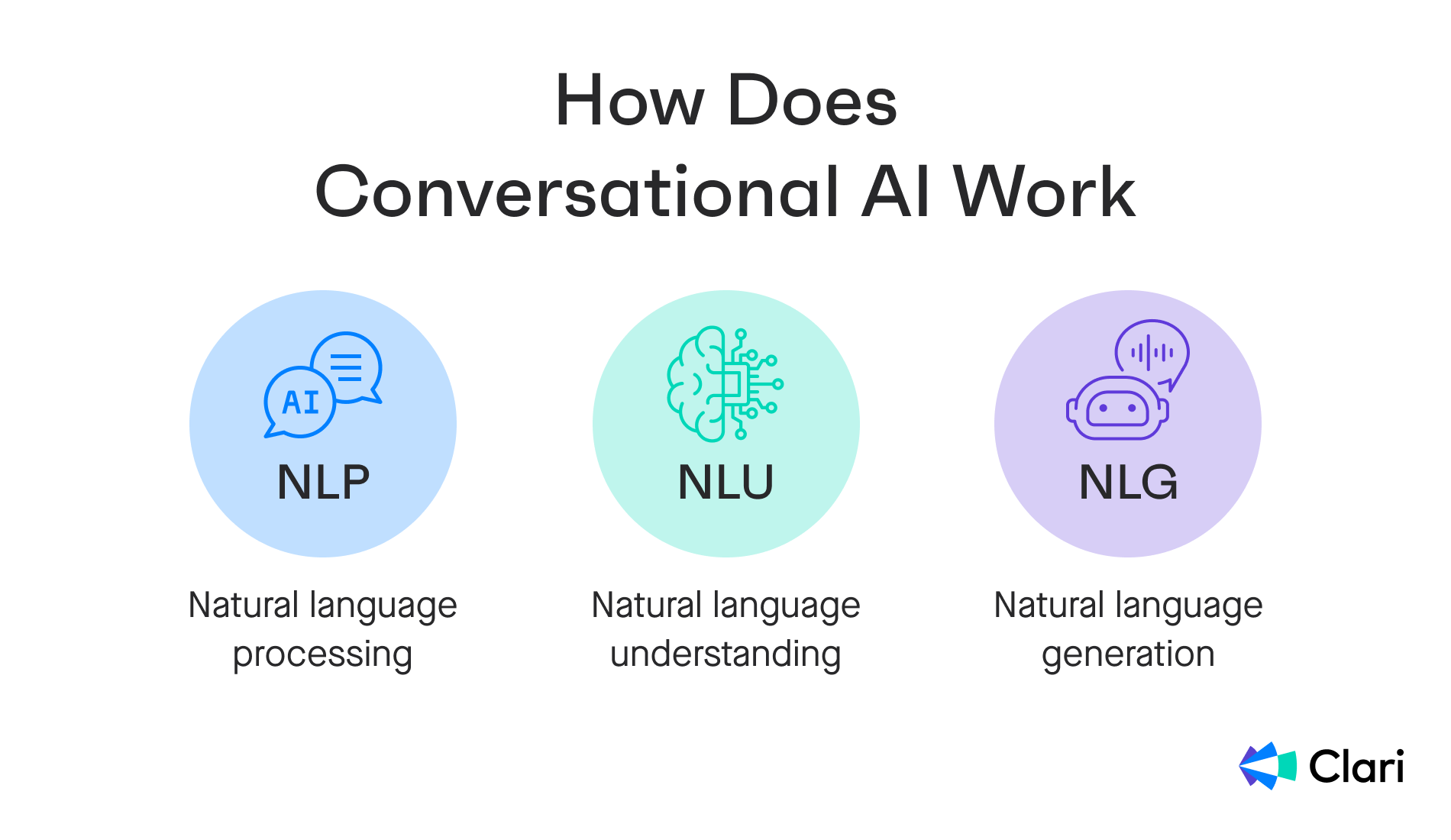
- Natural language processing (NLP): This set of techniques and algorithms allows machines to understand and analyze human speech. NLP machine learning algorithms enable artificial intelligence models to continuously learn from a vast database to recognize linguistic patterns, sentence structures, and grammar more easily.
- Natural language understanding (NLU): These machine learning algorithms help AI models process human language and understand intent and context. Two similar sentences could have very different meanings depending on the context, so NLU models are critical to ensuring your tool responds correctly.
- Natural language generation (NLG): These algorithms allow AI models to respond to inputs in a human-like manner. In other words, one that is coherent and contextually appropriate. NLG technology lets AI chatbots and tools like ChatGPT react impressively. The ability only gets better when these tools interact with customers and employees.
What are the benefits of conversational AI?
Using conversational AI across your business has several benefits, from boosting your bottom line to increasing employee productivity and improving the customer experience.
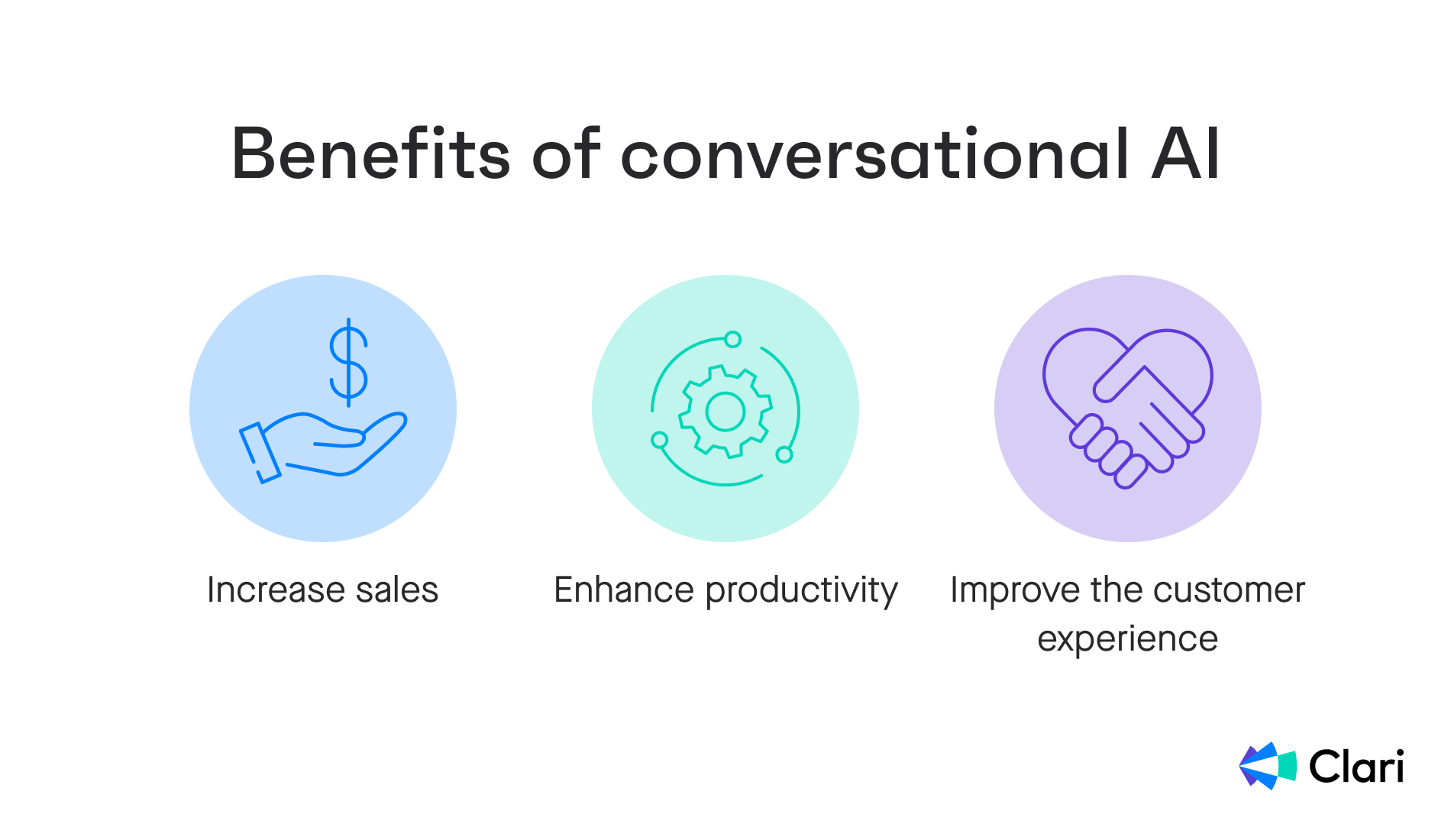
Increase sales
One of the most commonly cited benefits of conversational AI is cost efficiency. AI chatbots can reduce business costs like salaries and training by replacing human agents.
But artificial intelligence isn’t just a cost-saving method. Rather than replacing humans, businesses should understand the potential of conversational AI to augment their human employees’ capabilities and significantly increase revenue.
For example, a sales-focused conversational AI tool can help reps deliver a better experience to potential customers, help them navigate objections, and close more deals. These tools can also help reps reduce customer service wait times, soaring customer satisfaction levels, and reduce churn.
Enhance productivity
Is manual administrative work bogging down your team? Conversational AI can share the load, allowing your team to focus on revenue-related tasks.
For example, conversational AI tools can do manual work for sales and customer success teams. They can answer customer queries independently with little to no human assistance, automatically transcribe and summarize sales calls, and even highlight the next steps your sales team should take.
Improve the customer experience
Conversational AI can fulfill your customers' demands for immediate gratification by providing instantaneous answers at almost any point in the customer journey.
It helps sales reps and customer engagement teams to deliver a more personalized experience to prospects and customers. A conversational AI tool can use purchase data to recommend a relevant product, for example, or tell human reps about a customer's previous problems in real time.
Real-world examples of how to use conversational AI
Want to understand how you can incorporate conversational AI into your business or product? Try one of the following real-world use cases.
Sales assistant
An AI sales assistant may not be the first conversational AI use case you think of, but it’s one of the most powerful ways to use this technology. A tool like Clari Copilot can optimize your sales playbook on the fly, help reps overcome objections in real time during a sales call, and even reply to prospects automatically.
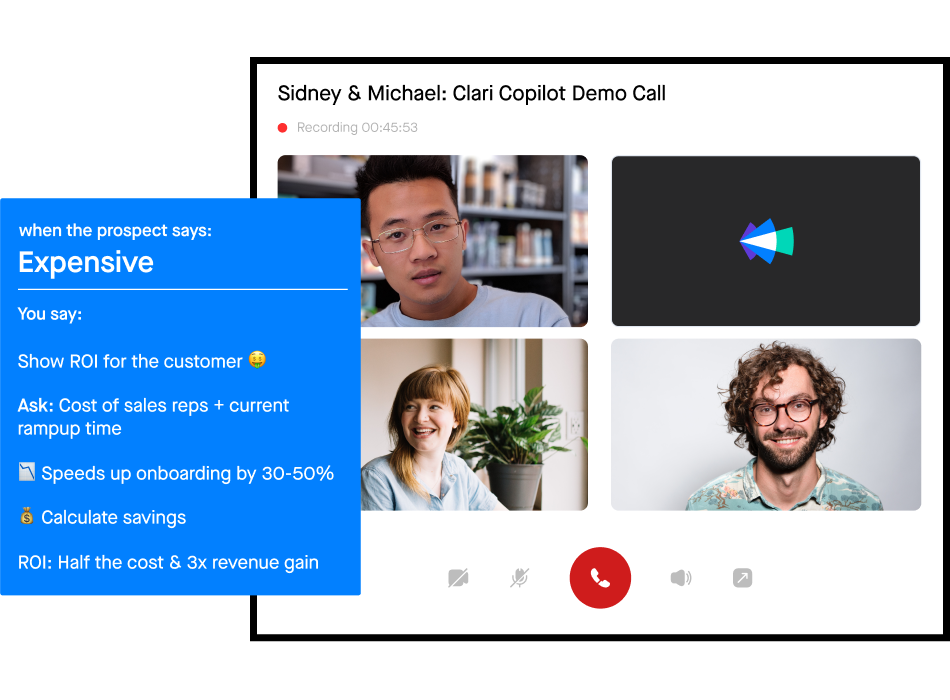
PartsBase, the world's largest B2B online parts locator service for aviation and aerospace, uses Clari Copilot to monitor outcomes and improve the quality of their sales teams' conversations. For example, the tool identified that sellers focusing on video calls compared to IVR calls have better conversations and close deals faster.
It’s become a core part of the team’s sales funnel, says Rodrigo Garcia, VP, Chief Technology and Transformation Officer at PartsBase:
“Clari Copilot participates in our sales funnel from day one—the initial contact we try to make with the lead till the day that the deal is closed. All of those conversations are analyzed and recorded on the CRM through Clari Copilot.”
Customer chatbot
Chatbots are one of the biggest use cases for conversational AI and the one readers will probably be most familiar with. Over half (54%) of businesses use some form of chatbot or conversational AI platform in customer-facing applications, according to a Gartner customer services and support survey.
Businesses can train Conversational AI platforms on vast swathes of customer and business data, allowing them to learn the most appropriate responses to the most common questions.
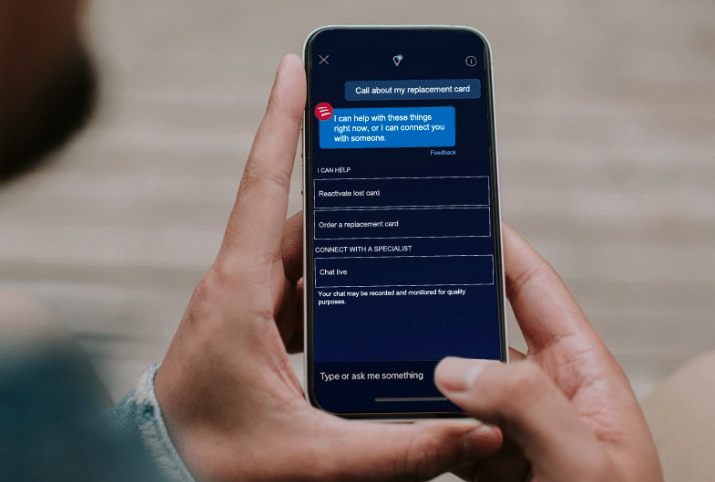
Bank of America’s Erica is an excellent example of a conversational AI chatbot. The app uses customer data to provide personalized insights and advice round the clock. It can complete simple tasks on behalf of customers and transfer them to human agents when necessary.
HR onboarding and training
Your HR team is responsible for a lot, from recruiting and onboarding to training and managing employees' day-to-day experience. So give them a break. Conversational AI tools can optimize and automate dozens of HR processes.
So rather than have an employee sit down with a new hire and walk them through your company’s policies, tools, and training material, deploy an AI chatbot instead.
That’s the approach the mobile app analytics platform UXCam took. The team uses Clari Copilot to create a database of relevant call scenarios so new hires can get up to speed quickly. Managers also use Copilot to streamline call reviews and quickly identify training topics.
Virtual assistants
Virtual assistants like Siri and Alexa are another common use case of conversational AI. These apps use voice recognition to understand and answer your questions using natural language generation models.
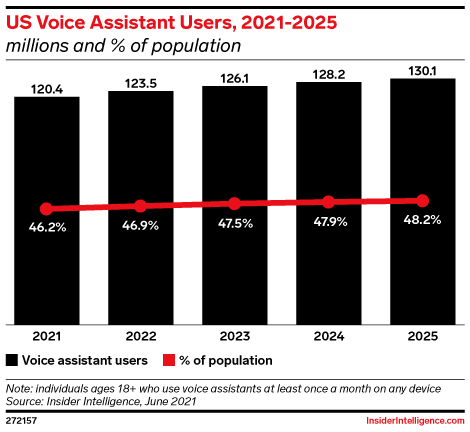
These apps are incredibly popular with consumers. Over 123 million US adults use voice assistants at least once per month. However, they are less common in a business setting where text-based assistants like ChatGPT are more popular.
What are the challenges of conversational AI, and how do you overcome them?
There are several challenges you may face when implementing a conversational AI tool. Here’s what you can expect and how you can overcome them:
- Privacy and security: Conversational AI models only work if they can collect and analyze significant amounts of customer data. That means there will always be data privacy and security issues.
- The only way to avoid security breaches and give you peace of mind is to choose a tool that meets strict security protocols like SOC 2 Type 2 and GDPR.
- Language nuances: Conversational AI does an incredible job of mimicking human conversations, but they aren’t infallible. In particular, a general AI won’t necessarily understand the language nuances of your industry or other slang it hasn’t been trained on.
- The solution? Use a specialist conversational AI that better understands the context of the situation.
- User adoption: Conversational AI tools become more powerful and effective when people use them. The higher your adoption rate, the more data your tool can collect and the more accurate it will become.
- There are a couple of ways you can increase adoption. The first is to choose a tool with fantastic usability so employees will want to use it. You can check this during a product demo.
- The second is to educate employees on the capabilities and benefits of your conversational AI tool so they understand exactly how they can benefit.
4 best practices for using conversational AI
You know what conversational AI is and how it works. Now, let’s discuss how to make the most of this technology. Follow these four best practices to implement them effectively.
Define your business goals
Start your conversational AI journey by clearly defining why you want to implement such a solution and how you plan to use it.
Is it a customer support play that takes the weight off your support rep’s shoulders? Or are you empowering your sales team with an AI sidekick?
It doesn’t matter why you want to implement this technology as long as it aligns with your long-term business goals.
Choose the right tool
There’s certainly no shortage of conversational AI tools. But how do you choose the best one for your business?
Clarifying your goals will help to narrow your focus. So will calculating a budget. But let’s go further.
Ideally, you’ll want to choose an industry-specific tool where possible. This will help you overcome some of the challenges we discussed above and ensure several relevant customer success stories can shed light on the potential of your new platform.
You should also consider your long-term needs. Does your chosen platform scale with your business and fulfill your future AI needs? Or are you paying for features you will probably never use?
Integrate conversational AI into your workflow
Conversational AI isn’t just an interface you can use to question and command. It becomes much more powerful when you integrate it with as much of your technology stack as possible.
So hook it up to your CRM, integrate it with your messaging platform, and see how it communicates with other tools to become an integral part of your sales process.
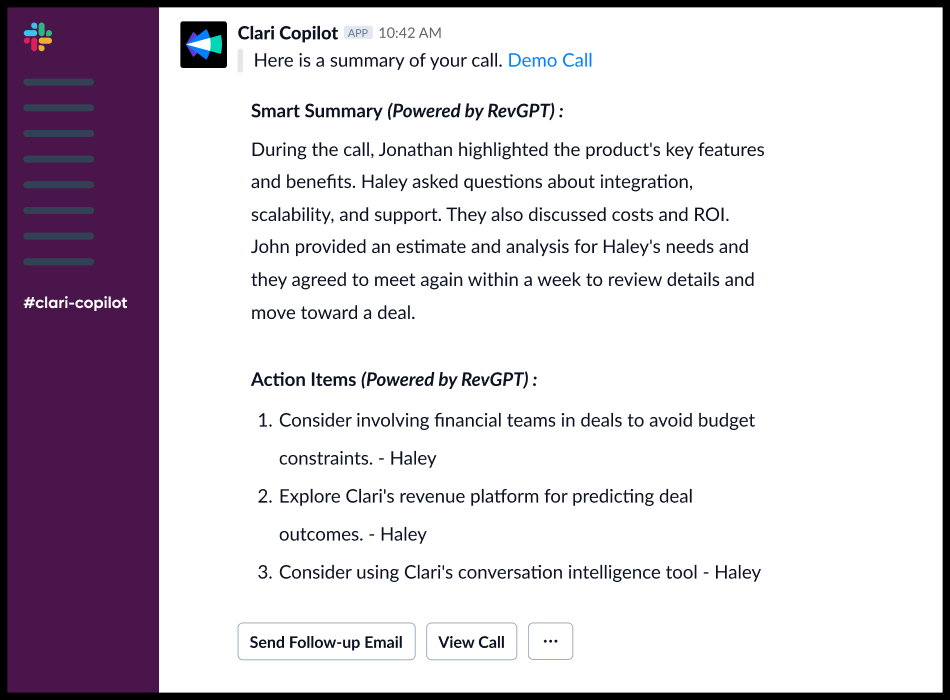
Clari Copilot, for example. Integrates with Slack to automatically send a summary of every sales call, including action items and next steps. You don’t even have to ask. It just delivers.
Know when to use AI and when to take over
There’s a lot that these AI tools can do, but there’s plenty of stuff your employees are better suited at. The key to success with conversational AI is knowing which tasks a bot should handle and which tasks your employees should take care of.
Administrative work, for example, is perfect for AI tools. You can also use them to suggest actions or devise strategies. However, take care when using these tools for client-facing work without having an employee check things first.
If you’re using a conversational AI tool as a customer service chatbot, it will also be important to establish when the bot should be handed over to a human customer service rep.
The future of conversational AI
We will likely see more conversational AI trends in the future: voice chatbots and proactive customer service agents.
Most conversational AI tools like ChatGPT are text-based. However, that could change in the latter half of the decade as voice chatbots become more popular. These chatbots use natural language processing algorithms to understand and respond to spoken commands and queries, allowing customers and employees to engage with them more naturally.
Proactive conversation AI tools don’t wait for customers to contact them. These tools can monitor customer behavior and preempt their needs, proactively reaching out to offer support and advice. This should reduce customer frustration, boost customer satisfaction, and improve conversion rates.
Try the only revenue-focused conversational intelligence solution
Conversational AI tools can help you increase sales, boost productivity, and improve the customer experience. But don’t settle for a general application solution. If you care about increasing revenue, choose the only revenue-focused conversational intelligence solution: Clari Copilot.
Our tool provides reps with real-time battle cards to overcome objections, helps them learn winning behaviors from cherry-picked game types, and creates formatted call summaries in seconds.




